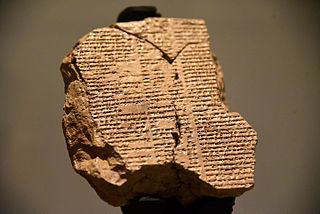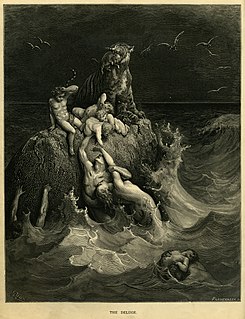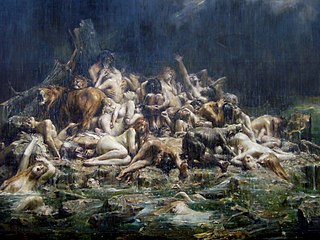 W
WMesopotamian mythology refers to the myths, religious texts, and other literature that comes from the region of ancient Mesopotamia in modern-day West Asia. In particular the societies of Sumer, Akkad, and Assyria, all of which existed shortly after 3000 BCE and were mostly gone by 400 CE. These works were primarily preserved on stone or clay tablets and were written in cuneiform by scribes. Several lengthy pieces have survived, some of which are considered the oldest stories in the world, and have given historians insight into Mesopotamian ideology and cosmology.
 W
WThe Agušaya Hymn or Song of Agušaya is an Old Babylonian literary work, a “song of praise”, written in the Akkadian language concerning the goddess Ištar, identified with the serpent deity Irnina. It may have been called “the Snake has Turned” in antiquity, as it has ú-ta-ar MUŠ inscribed at the top edge at the beginning. It is extant on two unprovenanced tablets, designated A and B, the latter of which includes a request for eternal life for king Ḫammu-rāpī, on the fifth column, 26th line, for whom it is thought to have been composed as an epic hymn of celebration of “the mad dancer in battle”. It is arranged into ten kirugú-stanzas and six ĝešgiĝal-antiphons as lyrical retorts, the numbering of which suggest that the work extends over the two tablets, although the second may not be the actual sequel of the first as the first is an eight column tablet while the second only has six columns and there are apparently subtle differences in late Old Babylonian cursive cuneiform distinguishing them, suggesting tablet A is the younger copy.
 W
WThe work known by its incipit, Angim, "The Return of Ninurta to Nippur", is a rather obsequious 210-line mythological praise poem for the ancient Mesopotamian warrior-god Ninurta, describing his return to Nippur from an expedition to the mountains (KUR), where he boasts of his triumphs against "rebel lands" (KI.BAL), boasting to Enlil in the Ekur, before returning to the Ešumeša temple – to “manifest his authority and kingship.”
 W
WAtra-Hasis is an Akkadian epic, recorded in various versions on clay tablets, named for its protagonist, Atrahasis. The Atra-Hasis tablets include both a creation myth and one of three surviving Babylonian flood myths. The name "Atra-Hasis" also appears, as king of Shuruppak in the times before a flood, on one of the Sumerian King Lists.
 W
WThe Barton Cylinder is a Sumerian creation myth, written on a clay cylinder in the mid to late 3rd millennium BCE, which is now in the University of Pennsylvania Museum of Archaeology and Anthropology. Joan Goodnick Westenholz suggests it dates to around 2400 BC.
 W
WThe "Debate between sheep and grain" or "Myth of cattle and grain" is a Sumerian creation myth, written on clay tablets in the mid to late 3rd millennium BCE.
 W
WThe Debate between Winter and Summer or Myth of Emesh and Enten is a Sumerian creation myth, written on clay tablets in the mid to late 3rd millennium BC.
 W
WEnlil and Ninlil or the Myth of Enlil and Ninlil or Enlil and Ninlil: The begetting of Nanna is a Sumerian creation myth, written on clay tablets in the mid to late 3rd millennium BC.
 W
WThe Enūma Eliš is the Babylonian creation myth. It was recovered by English archaeologist Austen Henry Layard in 1849 in the ruined Library of Ashurbanipal at Nineveh. A form of the myth was first published by English Assyriologist George Smith in 1876; active research and further excavations led to near completion of the texts and improved translation.
 W
WA flood myth or deluge myth is a myth in which a great flood, usually sent by a deity or deities, destroys civilization, often in an act of divine retribution. Parallels are often drawn between the flood waters of these myths and the primaeval waters which appear in certain creation myths, as the flood waters are described as a measure for the cleansing of humanity, in preparation for rebirth. Most flood myths also contain a culture hero, who "represents the human craving for life".
 W
WThe Genesis flood narrative is a flood myth found in the Tanakh. The story tells of God's decision to return the Earth to its pre-creation state of watery chaos and then remake it in a reversal of creation. The narrative has very strong similarities to parts of the Epic of Gilgamesh which predates the Book of Genesis.
 W
WThe Hymn to Enlil, Enlil and the Ekur , Hymn to the Ekur, Hymn and incantation to Enlil, Hymn to Enlil the all beneficent or Excerpt from an exorcism is a Sumerian myth, written on clay tablets in the late third millennium BC.
 W
WThe Kesh Temple Hymn or Liturgy to Nintud or Liturgy to Nintud on the creation of man and woman is a Sumerian tablet, written on clay tablets as early as 2600 BCE. Along with the Instructions of Shuruppak, it is the oldest surviving literature in the world.
 W
WThe lament for Sumer and Urim or the lament for Sumer and Ur is a poem and one of five known Mesopotamian "city laments"—dirges for ruined cities in the voice of the city's tutelary goddess.
 W
WThe Lament for Ur, or Lamentation over the city of Ur is a Sumerian lament composed around the time of the fall of Ur to the Elamites and the end of the city's third dynasty.
 W
WLugalbanda in the Mountain Cave is a Sumerian mythological account. It is one of the four known stories that belong to the same cycle describing conflicts between Enmerkar, king of Unug (Uruk), and an unnamed king of Aratta. The story is also referred to as “Lugalbanda in the Wilderness” or “Lugalbanda I” and followed by the story known as Lugalbanda and the Anzu Bird, together forming the two parts of one story. The stories, from the composer’s point of view, take place in the distant past. The accounts are believed to be composed during the Ur III Period, although almost all extant copies come from Isin-Larsa period. Tablets containing these stories were found in various locations of southern Iraq, primarily in the city of Nippur, and were part of the curriculum of Sumerian scribal schools during the Old Babylonian period.
 W
WThe ancient Mesopotamian myth beginning Lugal-e ud me-lám-bi nir-ğál, also known as Ninurta's Exploits is a great epic telling of the warrior-god and god of spring thundershowers and floods, his deeds, waging war against his mountain rival á-sàg, destroying cities and crushing skulls, restoration of the flow of the river Tigris, returning from war in his “beloved barge” Ma-kar-nunta-ea and afterward judging his defeated enemies, determining the character and use of 49 stones, in 231 lines of the text. It is a bilingual work with origin in the late third millennium.
 W
WOld Babylonian oracle is a Sumerian myth, written on clay tablets dated to between 2340 and 2200 BC.
 W
WSelf-praise of Shulgi is a Sumerian myth, written on clay tablets dated to between 2100 and 2000 BC.
 W
WThe Song of the hoe or the Creation of the pickax is a Sumerian creation myth, written on clay tablets from the last century of the 3rd millennium BCE.